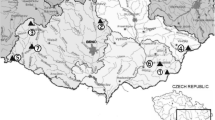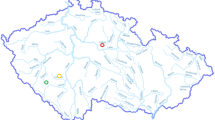Abstract
Total mercury levels were quantified in Tilapia mossambicus, Cirrhinus mrigela and Labio rohita, captured from East Calcutta Wetlands and Titagarh sewage fed aquaculture ponds. The bioconcentration factor of collected fish was assessed. Total mercury level ranged from 0.073 to 0.94 μg/g in both pre and post monsoon season. T. mossambicus in both season and C. mrigela at pre monsoon, cross the Indian recommended maximum limit (0.50 μg/g wet weight) for food consumption and according to World Health Organization guidelines all fish were not recommended for pregnant women and individuals under 15 years ages. A significant correlation was observed between mercury content of aquaculture pond water and fish muscle tissue. Total mercury concentration in experimental sites were higher than the control area (Wilcoxon Ranked-Sum test p > 0.05), which suggested the connection between mercury bioaccumulation and sewage fed aquaculture.




Similar content being viewed by others
References
Agarwal R, Kumar R, Behari JR (2007) Mercury and lead content in fish species from the River Gomti, Lucknow, India, as biomarkers of contamination. Bull Environ Contam Toxicol 78:118–122
Altindag A, Yigit S (2005) Assessment of heavy metal concentrations in the food web of lake Beysehir, Turkey. Chemosphere 60:552–556
APHA (1995) Standard methods, 19th edn. American Public Health Association, Washington, DC
Campbell LM, Dixon DG, Hecky RE (2003) Review of mercury in Lake Victoria, East Africa: implications for human and ecosystem health. J Toxicol Environ Health Part B 6:325–356
Carvalho ML, Santiago S, Nunes ML (2005) Assessment of the essential element and heavy metal content of edible fish muscle. Anal Bioanal Chem 382:426–432
Chang LW (1977) Neurotoxic effects of mercury—a review. Environ Res 14:329
Clarkson TW (1987) Metal toxicity in the central nervous system. Environ Health Perspect 75:59–64
Darnton-Hill I, Hassan N, Karim R, Duthie MR (1988) Tables of nutrient composition of Bangladeshi foods. English version with particular emphasis on vitamin A content. Helen Keller International, Dhaka, Bangladesh
De La Rosa D, Lima L, Olivares-Rieumont S, Graham DW, Enriquez I, Diaz O, Bastýás JM, Munoz O (2009) Assessment of total mercury levels in Clarias gariepinus from the Sagua la Grande River, Cuba. Bull Environ Contam Toxicol 82:101–105
Gammons CH, Slotton DG, Gerbrandt B, Weight W, Young CG, McNearny RL, Camac E, Calderon R, Tapia H (2006) Mercury concentration of fish, river water, and sediment in the Rio Ramis-Lake Titicaca Watershed. Peru Sci Total Environ 368:637–648
IRIS- Integrated Risk Information System (1993) EPA, Office of Research and Development, Washington, DC
Louria DB (1992) Trace metal poisoning. In: Wyngaarden JB, Smith LH Jr, Bennet JC (eds) Cecil textbook of medicine, vol 2, 19th edn. Saunders Co., Philadelphia 2380 p
Morel FM, Kraepiel MAML, Amyot M (1998) The chemical cycle and bioaccumulation of mercury. Annu Rev Ecol Syst 29:543–566
Paul RS (1987) Incidence of methylmercury in fish from Stanley reservoir (Mettur), Tamil Nadu, India. J Environ Biol 8:151–155
PFA Act (1954) The Prevention of Food Adulteration Act, 1954, together with Prevention of Adulteration Rules, 1955, and Notification and Commodity Index, India (amended, 2002) Eastern Book Company, Lucknow. Table No. R-57:106–110
Rainbow PS (1985) The biology of heavy metals in the sea. Int J Environ Stud 25:195–211
Sinha RK, Sinha SK, Kedia DK, Kumari A, Rani N, Sharma G, Prasad K (2007) A holistic study on mercury pollution in the Ganga river system at Varanasi, India. Curr Sci 92(9):1223–1227
World Health Organization (1990) Environmental Health Criteria 101: methylmercury. World Health Organization, Geneva
Zhang L, Zang X, Xu J, Xie P, Zhu Z, Su J (2007) Mercury bioaccumulation in fishes of three Gorges reservoir after impoundment. Bull Environ Contam Toxicol 78:262–264
Acknowledgments
The authors gratefully acknowledge Department of Environmental Science, University of Kalyani for providing support and necessary facilities for research work.
Author information
Authors and Affiliations
Corresponding author
Rights and permissions
About this article
Cite this article
Bhattacharyya, S., Chaudhuri, P., Dutta, S. et al. Assessment of Total Mercury Level in Fish Collected from East Calcutta Wetlands and Titagarh Sewage Fed Aquaculture in West Bengal, India. Bull Environ Contam Toxicol 84, 618–622 (2010). https://doi.org/10.1007/s00128-010-9972-5
Received:
Accepted:
Published:
Issue Date:
DOI: https://doi.org/10.1007/s00128-010-9972-5




